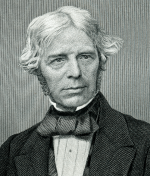English scientist Michael Faraday FRS (22 September 1791 – 25 August 1867) made significant contributions to the study of electrochemistry and electromagnetism. His major discoveries include the fundamentals of electrolysis, diamagnetism, and electromagnetic induction. Despite having minimal formal schooling, Faraday was one of history's most important scientists. Faraday developed the idea of the electromagnetic field in physics through his study of the magnetic field surrounding a conductor carrying a direct current. Faraday also proved that there was a connection between the two phenomena and that magnetism could impact light rays.
He also discovered the rules of electrolysis and the fundamentals of electromagnetic induction and diamagnetism. Electric motor technology was built on his electromagnetic rotary device ideas, and it was essentially his work that made electricity practicable for application in technology.
As a chemist, Faraday made numerous scientific discoveries, including the discovery of benzene, research into the clathrate hydrate of chlorine, creation of an early version of the Bunsen burner and the system of oxidation numbers, and popularization of terms like "anode," "cathode," "electrode," and "ion." Faraday eventually earned a lifelong appointment at the Royal Institution as the first and foremost Fullerian Professor of Chemistry. Faraday was an experimentalist who used straightforward language to express his thoughts, but his mathematical prowess was restricted to the most basic algebra and did not include trigonometry. All current theories of electromagnetic phenomena are based on a set of equations created by James Clerk Maxwell, who took the work of Faraday and others and condensed it.
According to Maxwell's analysis of Faraday's use of lines of force, these approaches reveal Faraday "to have been in reality a mathematician of a very high order - one from whom the mathematicians of the future may derive valuable and fertile methods." The farad, a SI unit of capacitance, is named in his honor.
Along with images of Arthur Schopenhauer and James Clerk Maxwell, Albert Einstein kept a picture of Michael Faraday on the wall of his study. According to physicist Ernest Rutherford, "There is no honor too great to pay to the memory of Faraday, one of the greatest scientific discoverers of all time, when we consider the magnitude and extent of his discoveries and their influence on the progress of science and of industry."
Early life
In Newington Butts, Surrey (which is now a part of the London Borough of Southwark), Michael Faraday was born on September 22, 1791. His family didn't have much money. James, his father, belonged to the Glasite branch of Christianity. James Faraday left Outhgill, Westmorland, where he had been an apprentice to the local blacksmith, and relocated his wife Margaret (née Hastwell) and two kids to London during the winter of 1790. Autumn of that year saw the birth of Michael. With only the most fundamental schooling, the young Michael Faraday, the third of four children, had to educate himself.
He started working as an apprentice for local bookbinder and bookseller George Riebau in Blandford Street when he was 14 years old. Faraday read numerous works over his seven-year apprenticeship, including Isaac Watts' The Improvement of the Mind, and he eagerly put its ideas into practice. Faraday attended lectures on various scientific subjects at the City Philosophical Society during this time and exchanged talks with his colleagues there. He also grew interested in physics, particularly electricity. Conversations on Chemistry by Jane Marcet was one source of inspiration for Faraday in particular.
Scientific Achievements
As Humphry Davy's assistant, Faraday performed some of the early chemical research. As part of his research on chlorine, Faraday found two new chlorine and carbon compounds: hexachloroethane and carbon tetrachloride. He produced the former by chlorinating ethylene, and the latter by decomposing the former. He also carried out the first rudimentary tests on the phenomenon of gas diffusion, which was first noted by John Dalton. Thomas Graham and Joseph Loschmidt provided a more thorough explanation of the phenomenon's physical significance. Faraday was successful in liquefying a number of gases, studied steel alloys, and created a number of novel glass types with optical applications.
The rotation of the plane of polarization of light was later discovered by Faraday using a specimen of one of these heavy glasses that later proved significant historically. This specimen was the first thing that was discovered to reject a magnet's poles.
Faraday created an early version of the Bunsen burner, which is currently utilized as a viable heat source in science labs all around the world. Faraday made significant contributions to the area of chemistry by liquefying gases like chlorine and discovering chemicals like benzene, which he termed bicarburet of hydrogen. Gas liquefaction made it clear that gases are the vapours of liquids with extremely low boiling points and provided greater support for the idea of molecular aggregation. Faraday reported the first synthesis of C2Cl6 and CCl4—compounds created from carbon and chlorine—in 1820, and the following year he published the results.
Humphry Davy had found the chlorine clathrate hydrate in 1810; Faraday also identified its chemical make-up. Along with popularizing terms like anode, cathode, electrode, and ion, which were mostly proposed by William Whewell, Faraday is also credited with finding the rules of electrolysis.
The first person to describe what is now known as metallic nanoparticles was Faraday. He found that the optical characteristics of gold colloids were distinct from those of the corresponding bulk metal in 1847. This may be regarded as the beginning of nanoscience as it was most likely the first observation of the effects of quantum scale to be publicly reported.

